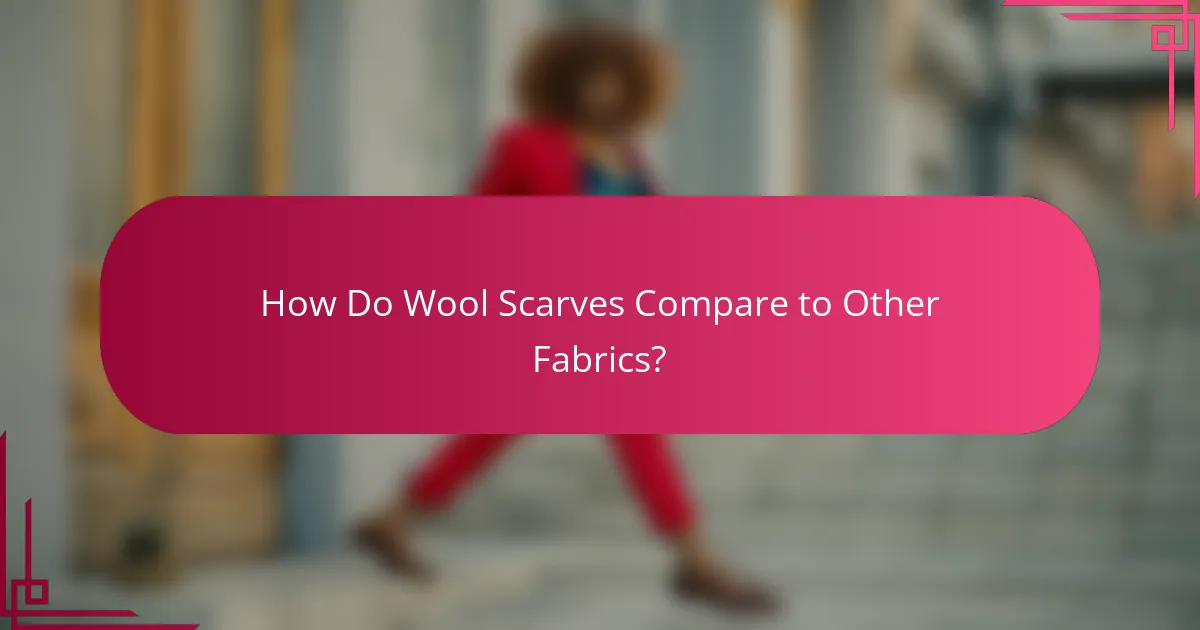Wool scarves are a versatile fashion accessory known for their warmth, durability, and luxurious texture. This article explores the enduring appeal of wool scarves, highlighting their insulation properties, moisture-wicking capabilities, and historical significance in fashion. Current trends include oversized styles, vibrant colors, and textured patterns, showcasing how wool scarves can enhance both casual and formal outfits. Additionally, the article addresses the care and maintenance differences between wool and cashmere, emphasizing the unique properties of each material. Overall, wool scarves remain a stylish and practical choice for cold weather, adaptable to various fashion trends.

What Makes Wool Scarves Timeless?
Wool scarves are timeless due to their blend of warmth, durability, and versatility. The natural fibers provide excellent insulation, making them ideal for cold weather. Wool also has moisture-wicking properties, keeping wearers dry and comfortable. The texture of wool adds a luxurious feel, enhancing both casual and formal outfits. Historically, wool has been used for centuries, showcasing its long-lasting appeal. Fashion trends frequently incorporate wool scarves, ensuring they remain in style across generations. Their ability to be easily styled in various ways contributes to their enduring popularity.
How do wool scarves provide warmth?
Wool scarves provide warmth through their insulating properties. Wool fibers trap air, creating a layer of warmth around the body. This natural insulation helps retain heat even in cold conditions. Additionally, wool has moisture-wicking abilities, keeping the skin dry and comfortable. The structure of wool fibers allows them to expand and contract, enhancing their thermal regulation. Studies show that wool can maintain warmth even when wet, making it effective in various weather conditions. Overall, the combination of insulation and moisture management makes wool scarves a reliable choice for warmth.
What properties of wool contribute to its insulation?
Wool’s insulation properties stem from its unique fiber structure and moisture management. The crimp in wool fibers creates air pockets, enhancing thermal insulation. These air pockets trap heat close to the body, maintaining warmth. Wool also absorbs moisture without feeling wet, which helps regulate temperature. This moisture-wicking ability keeps the wearer dry and comfortable. Additionally, the natural elasticity of wool fibers allows them to retain their shape. This resilience contributes to long-lasting insulation performance. Studies show that wool can retain warmth even when damp, making it effective in various conditions.
How does the weave of wool affect its thermal qualities?
The weave of wool significantly influences its thermal qualities. Different weaves create varying levels of insulation and breathability. For example, a tighter weave traps more air, enhancing warmth. Conversely, a looser weave allows for better airflow, which can reduce heat retention. The structure of the fibers also plays a role in thermal regulation. Wool fibers have natural crimp, which creates air pockets, further improving insulation. Research indicates that the thermal conductivity of wool can vary based on weave density. This means that the choice of weave directly impacts how warm a wool scarf will feel when worn.
What textures are found in wool scarves?
Wool scarves exhibit a variety of textures. Common textures include smooth, soft, and coarse. Smooth textures are often achieved through fine wool fibers. Soft textures provide comfort against the skin, enhancing wearability. Coarse textures can add a rustic charm and durability. Additionally, some wool scarves feature ribbed or cable-knit patterns. These designs contribute to the visual appeal and tactile experience. The diversity in textures allows for versatility in fashion and function.
How do different knitting techniques influence texture?
Different knitting techniques significantly influence the texture of knitted fabrics. Techniques such as garter stitch create a squishy, bouncy texture. In contrast, stockinette stitch results in a smooth, flat surface. Cable knitting introduces raised patterns, adding dimension and complexity. Lace knitting creates openwork designs, contributing a delicate and airy feel. Each technique alters the way light interacts with the fabric, affecting its visual appearance. Textured stitches can also enhance warmth by trapping air, improving insulation. Therefore, the choice of knitting technique directly impacts both the tactile and visual qualities of the finished piece.
What is the sensory experience of wearing wool scarves?
Wearing wool scarves provides a unique sensory experience characterized by warmth, softness, and texture. The wool material retains heat, making it ideal for cold weather. This warmth envelops the neck, providing comfort during chilly conditions. The texture of wool is often described as soft yet slightly coarse, which can stimulate tactile sensitivity. Additionally, the natural fibers of wool allow for breathability, preventing overheating. The sensory experience also includes the distinctive smell of wool, which is often associated with nature and coziness. Many individuals find the sensation of wool against their skin to be comforting and soothing. Overall, the sensory experience of wearing wool scarves combines warmth, tactile pleasure, and a sense of security.
Why are wool scarves a staple in fashion trends?
Wool scarves are a staple in fashion trends due to their versatility and warmth. They can be styled in various ways, making them suitable for different occasions. Wool provides excellent insulation, keeping wearers warm in colder climates. The texture of wool adds a luxurious feel to outfits. Additionally, wool scarves come in diverse colors and patterns, enhancing their appeal. Historical trends show that wool scarves have remained popular across generations. Fashion designers frequently incorporate them into seasonal collections, reinforcing their status. The combination of practicality and style ensures wool scarves remain a fashion essential.
How have wool scarves evolved through fashion history?
Wool scarves have evolved significantly throughout fashion history. Initially, in ancient cultures, they served practical purposes for warmth. During the Middle Ages, wool scarves became symbols of status and wealth. In the 19th century, they gained popularity as fashionable accessories among the elite. The 20th century saw wool scarves embraced by various subcultures, including artists and intellectuals. Today, wool scarves are versatile fashion staples, available in numerous styles and patterns. Their evolution reflects broader fashion trends and societal changes. Wool scarves continue to combine functionality with aesthetic appeal.
What are the current fashion trends involving wool scarves?

How Do Wool Scarves Compare to Other Fabrics?
Current fashion trends involving wool scarves include oversized styles, vibrant colors, and textured patterns. Oversized wool scarves are popular for their versatility and warmth. They can be draped, wrapped, or tied in various ways. Vibrant colors are trending, moving away from traditional neutrals to bold hues. Textured patterns, such as cable knits and plaids, add visual interest. Layering wool scarves with other garments is also a common trend. This style enhances outfits while providing warmth. Wool scarves are often paired with winter coats, creating a chic look. Fashion influencers frequently showcase these trends on social media platforms.
What advantages do wool scarves have over synthetic materials?
Wool scarves offer superior insulation and breathability compared to synthetic materials. Wool naturally regulates temperature, keeping the wearer warm in cold conditions and cool in warmer weather. This is due to the unique structure of wool fibers, which trap air and provide excellent insulation. Additionally, wool can absorb moisture without feeling wet, allowing for comfort even in damp conditions. In contrast, synthetic materials often retain moisture and can lead to discomfort. Wool is also naturally odor-resistant, reducing the need for frequent washing. Furthermore, wool is biodegradable, making it an environmentally friendly choice over synthetic options. These attributes make wool scarves a practical and sustainable accessory.
How does the durability of wool compare with other fabrics?
Wool is generally more durable than many other fabrics, such as cotton and polyester. It has natural elasticity, allowing it to retain its shape and resist wear. Wool fibers can withstand bending and twisting without breaking. This durability is due to the unique structure of wool, which includes a protective outer layer. In contrast, cotton tends to wear out faster and can lose its shape over time. Polyester is strong but may not provide the same level of longevity as high-quality wool. Studies indicate that wool garments can last several years longer than their cotton counterparts under similar conditions.
What are the environmental impacts of choosing wool over synthetic options?
Wool has a lower environmental impact compared to synthetic options. Wool is biodegradable and can decompose naturally within a few years. This contrasts with synthetic fibers, which can take hundreds of years to break down. Additionally, wool production often requires less energy than producing synthetic materials. According to a study by the Textile Recycling Association, wool uses 80% less energy in its lifecycle compared to polyester. Furthermore, sheep farming can contribute to carbon sequestration, helping to mitigate climate change. In contrast, synthetic fibers are derived from fossil fuels, contributing to greenhouse gas emissions. Overall, choosing wool supports more sustainable practices and reduces long-term environmental harm.
What unique attributes set wool scarves apart from cotton or cashmere?
Wool scarves have unique attributes that distinguish them from cotton and cashmere. Wool is naturally insulating, providing warmth even when wet. This moisture-wicking property helps regulate body temperature. Wool fibers are also resilient, maintaining shape and structure over time. In contrast, cotton lacks this elasticity and can lose form. Cashmere, while soft and luxurious, is less durable than wool. Wool is also resistant to odors and stains, making it easier to care for. These attributes contribute to the lasting appeal and functionality of wool scarves in various climates.
How does moisture-wicking ability differ between wool and cotton?
Wool has superior moisture-wicking ability compared to cotton. Wool fibers can absorb up to 30% of their weight in moisture while still feeling dry. This is due to the structure of wool, which allows it to wick moisture away from the skin effectively. Cotton, on the other hand, absorbs moisture but does not wick it away. When cotton gets wet, it retains moisture, leading to a damp feeling against the skin. Research indicates that wool’s unique moisture management properties make it ideal for temperature regulation. Studies show that wool can help maintain warmth even when wet, unlike cotton, which loses insulation when damp.
What are the differences in care and maintenance for wool versus cashmere?

What Should You Consider When Choosing a Wool Scarf?
Wool and cashmere require different care and maintenance due to their unique properties. Wool is generally more durable and can withstand regular washing, often being machine washable on a gentle cycle. Cashmere, on the other hand, is more delicate and typically requires hand washing or dry cleaning to maintain its softness and shape.
Wool fibers are more resilient to stretching and shrinking, making them easier to care for. In contrast, cashmere fibers are finer and can easily lose their shape if not properly cared for. Wool can tolerate higher temperatures during washing, while cashmere should be washed in cold water to prevent damage.
Additionally, wool is less prone to pilling compared to cashmere, which tends to pill more easily due to its finer fibers. Therefore, cashmere requires regular de-pilling to maintain its appearance. Proper storage also varies; wool can be stored folded, while cashmere should be stored flat to avoid creasing.
What factors influence the quality of a wool scarf?
The quality of a wool scarf is influenced by several key factors. The type of wool used is crucial; Merino wool is known for its softness and durability. The yarn thickness also matters; thicker yarns provide better insulation. The weaving technique impacts the overall texture and warmth of the scarf. Additionally, the dyeing process can affect the colorfastness and appearance. Finally, the finishing treatments can enhance softness and reduce itchiness. Each of these factors contributes to the overall quality and user experience of the wool scarf.
How does the origin of wool affect its quality?
The origin of wool significantly affects its quality. Different breeds of sheep produce wool with varying characteristics. For example, Merino wool is known for its softness and fine texture. In contrast, wool from coarser breeds may be rougher and less desirable for garments. The environmental conditions where sheep are raised also influence wool quality. Sheep raised in colder climates tend to produce denser and warmer wool. Additionally, the shearing process and handling after shearing can impact the wool’s integrity. Quality control measures during these stages are crucial for maintaining high standards. Thus, the origin encompasses both breed and environmental factors that ultimately determine wool quality.
What should you look for in terms of craftsmanship?
Look for quality materials and attention to detail in craftsmanship. High-quality wool should be soft, durable, and sourced ethically. The stitching should be even and secure, indicating skillful construction. Check for consistent patterns and colors, reflecting precision in design. Evaluate the finishing touches, such as hems and labels, for professionalism. These factors contribute to the overall appeal and longevity of wool scarves. Quality craftsmanship enhances the scarf’s warmth and texture, making it a worthwhile investment.
How do you select the right style and color for your needs?
To select the right style and color for wool scarves, first identify your personal preferences and the occasion. Consider your wardrobe colors and existing styles to ensure compatibility. Evaluate the scarf’s texture and pattern to match your desired aesthetic. For instance, solid colors offer versatility, while patterns can add interest. Analyze seasonal trends, as certain colors may be more suitable for specific times of the year. Research shows that colors can influence mood; warm tones may evoke comfort, while cool tones can feel refreshing. Ultimately, choose a style and color that resonate with your personal style and fulfill your practical needs.
What are the trending colors and patterns for wool scarves this season?
Trending colors for wool scarves this season include earthy tones like olive green, rust, and mustard yellow. These shades reflect a connection to nature and warmth. Patterns that are popular include classic plaids, houndstooth, and geometric designs. These patterns provide visual interest and versatility. According to fashion reports, these colors and patterns align with current seasonal trends and consumer preferences. They are frequently seen in collections from major fashion brands this season.
How can you choose a wool scarf that complements your wardrobe?
To choose a wool scarf that complements your wardrobe, consider your existing color palette. Selecting a scarf in a neutral color can enhance versatility. Look for patterns that match or contrast with your clothing styles. Textures should also align with your outfits for a cohesive look. Pay attention to the length and thickness of the scarf; it should suit your personal style and the climate. Lastly, ensure the wool quality is high for durability and comfort. High-quality wool scarves often feature finer fibers, providing warmth without bulk.
What are the best practices for caring for your wool scarf?
To care for your wool scarf, hand wash it in cold water with a gentle detergent. Avoid hot water, as it can shrink the wool. Gently agitate the scarf without wringing or twisting it. Rinse thoroughly in cold water to remove all detergent. Lay the scarf flat on a clean towel to dry, reshaping it to its original form. Avoid hanging it, as this can stretch the fibers. Store the scarf in a cool, dry place away from direct sunlight. Use a breathable storage bag to prevent moth damage. Following these practices helps maintain the scarf’s texture and longevity.
Wool scarves are the central entity of this article, celebrated for their warmth, durability, and versatility. The article explores the insulating properties of wool, detailing how its unique fiber structure and moisture-wicking abilities contribute to comfort in cold weather. It also examines the various textures and knitting techniques that influence the aesthetic and tactile experience of wool scarves. Additionally, the article discusses the evolution of wool scarves in fashion history, current trends, and their advantages over synthetic materials, while providing guidance on selecting, caring for, and matching wool scarves with personal style.
